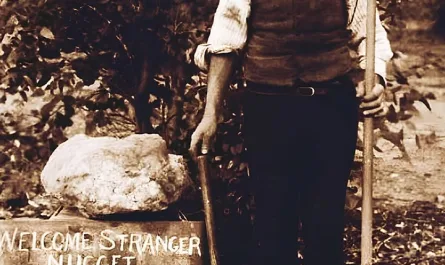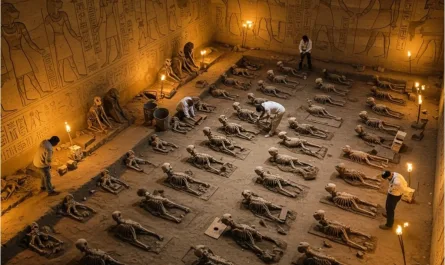Discovery and Context
In northern Serbia, two ceramic chariot models from the Late Bronze Age (ca. 1600–1200 BC) were unearthed in the village of Dupljaja, made in the Dubovac–Žuto Brdo / Garla Mare pottery tradition.
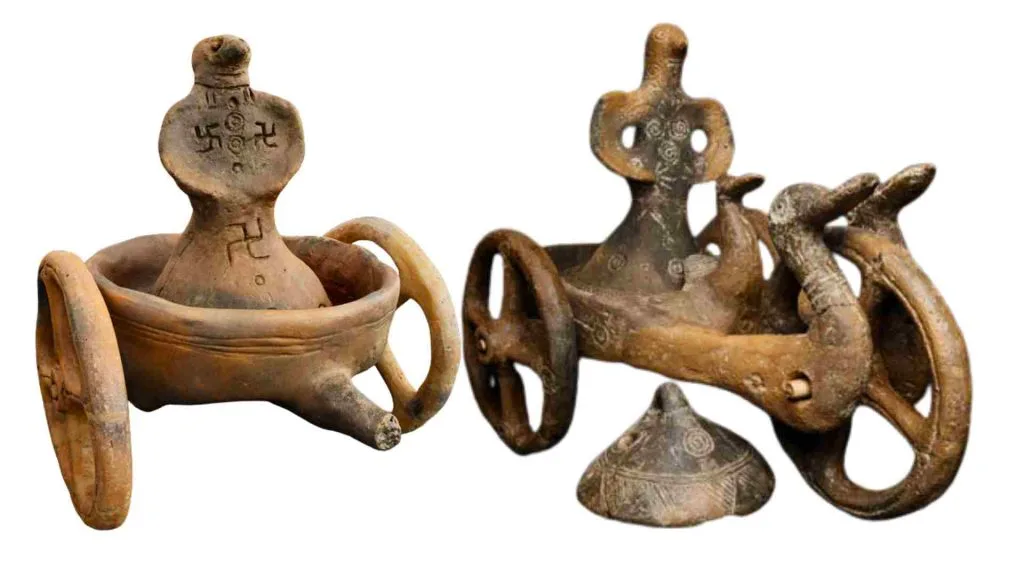
Their rotating wheels and worn surfaces prove active use — ritual or otherwise — and their design shows symbolic intent.
Each chariot bears a human figure — stylized and bird-faced (or with a bird mask). At least one figurine is likely male, with male genitalia under the skirt. Both are adorned with solar symbols such as the swastikas, circles and spirals.
The rich symbolism behind these artefacts has never been fully unraveled. It’s time we changed that.
The Umbrella Canopy — A Royal and Divine Symbol
The canopy marks the rider as sovereign or divine.
This arched canopy on a chariot is non-existent in European Bronze Age art but common in Vedic, Mesopotamian, and Assyrian iconography, where umbrellas signify royalty and divinity.
Vedic texts describe Aśvin-s, Indra, and Arjuna in covered chariots, symbols of prestige and divine authority.
The Dupljaja chariot is among the oldest known depictions of this kind of chariot anywhere in the world.
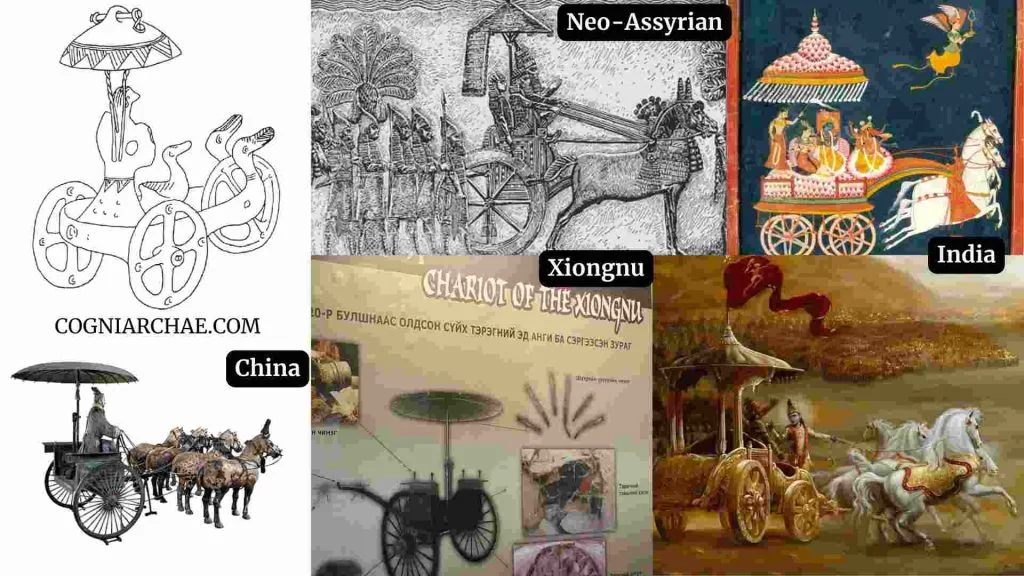
This Aryan tradition still lives in India, Cambodia, and Thailand through royal processions.
The Way of the Chariots
How chariots conquered the world.
Most historians and archaeologists attribute the introduction of chariots to the Indian subcontinent to Indo-Aryan–speaking groups who arrived during the late 3rd to early 2nd millennium BC.
Here’s the outline of what is known (and debated):
1. Archaeological record
• The earliest direct chariot finds in South Asia come from Sinauli (Uttar Pradesh), dated roughly to 2000–1800 BC. These were burials with solid-disk wheels and a pole for yoking animals. Whether they were true spoked-wheel war chariots or more like carts is still debated.
• True spoked-wheel chariots—lighter, faster vehicles associated with horse warfare—appear in the Near East and Central Asia around 2000 BC, linked to the Sintashta–Petrovka culture in the Eurasian steppe.
2. Linguistic evidence
• Vedic Sanskrit has an Indo-European chariot vocabulary (ratha, chakra, ashva, etc.) that closely matches cognates in other ancient Indo-European languages, suggesting a shared steppe origin.
• This points to chariots entering India alongside Indo-Aryan migrants from the north-west, via Central Asia and the Bactria–Margiana Archaeological Complex (BMAC) region.
3. Historical interpretation
• Most scholars see the Indo-Aryan migration (~2000–1500 BC) as the vector for introducing true horse-drawn, spoked-wheel chariots into India.
• Some Indian archaeologists propose that chariots were locally developed or introduced earlier via trade from the Near East, citing the Sinauli finds. This is controversial because those vehicles may have been ox-drawn and solid-wheeled, not the lightweight steppe war chariot.
4. Likely route
Eurasian steppe (Sintashta/Andronovo) → Central Asia/BMAC → north-west India (Punjab/Haryana) → spread into the Vedic cultural sphere.
However, some of the oldest known, Neolithic representations of wheeled vehicles come from Anatolia and the Balkans.
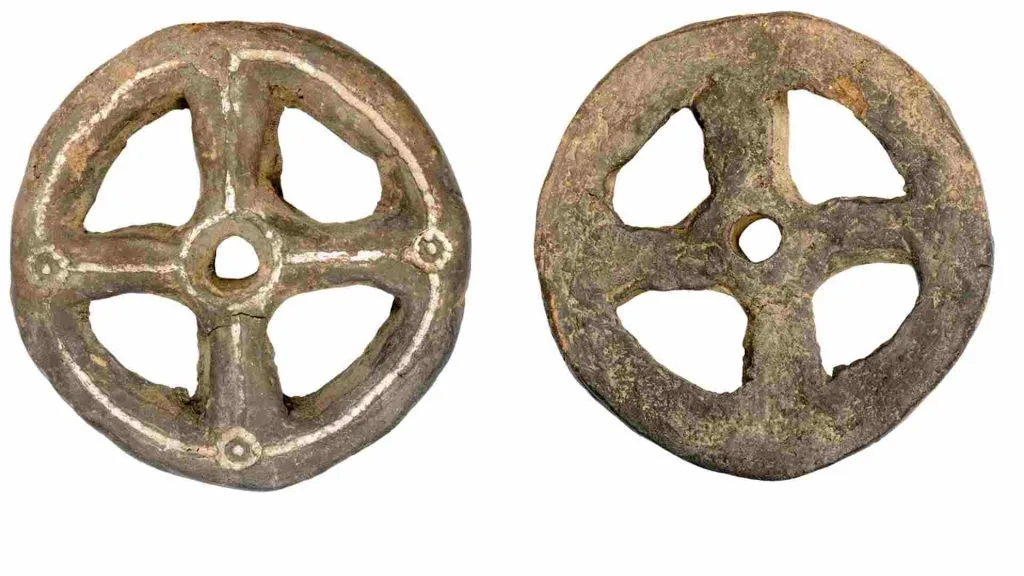
Four-Spoked wheels
One of the earliest form of wheels
With their four-spoked wheels, the Dupljaja chariots occupy a distinct branch on the evolutionary tree of wheel design:
1. Pre-spoke era (before ~2200 BC)
Solid wheels dominate — heavy, disk-shaped, made from planks.
Common in Mesopotamia, Indus Valley, and early Anatolia.
Used for ox-drawn carts, not fast warfare.
2. Early spoked wheels (2200–2000 BC)
First experiments with many spokes (6, 8, sometimes more) appear in the Near East and Caucasus.
Evidence:
Middle Elamite cylinder seals (Iran) — show carts with spoked wheels.
Maikop & Trialeti cultures — solid and possibly proto-spoked examples.
Likely too heavy for true chariot speed.
3. Four-spoke revolution (c. 2000–1900 BC)
Earliest secure archaeological finds:
Sintashta (Russia) – Kurgans 1, 5, and others show two-wheeled chariots with exactly four wooden spokes per wheel.
Krivoye Ozero and Arkaim – similar construction.
Wheels about 80–90 cm in diameter, hubs with axle sleeves, lightweight frames.
Function: Fast, maneuverable, horse-drawn vehicles for warfare and prestige.
Importance: This design dramatically reduced weight and allowed higher speeds.
4. Spread & diversification (1900–1500 BC)
West: Reaches Hittites & Near East (c. 1800 BC) — they often switch to six-spoke wheels for added strength on rough terrain.
South: Passes through BMAC and Indo-Iranian migration routes.
East: By ~1700–1500 BC, Indo-Aryan groups bring light four-spoke chariotsinto the Punjab and upper Ganges region (Rigvedic ratha).
5. Decline of the four-spoke standard
In most regions (including India), six- and eight-spoke wheels become common by the Late Bronze Age.
Reasons: Stronger under stress, especially for heavier loads or rough ground.
Four-spoke wheels remain in ceremonial or specialized uses.
The Third Wheel Mystery
The third wheel is deliberate — and may even hold sacred meaning.
One of the Dupljaja chariots has three wheels. That’s unusual. Real chariots had two, for speed and maneuverability. This model adds a third at the front, between the draught poles.
This third wheel is not decorative: it rotates and shows wear, but unlike the others, it’s mismatched in material and design — likely reused or added later. It has been suggested that the third wheel was added to prevent the model from tipping over.
However, three-wheeled chariots — though rare — do appear in some of the earliest chariot-related myths. In the Ṛgveda, the gods known as the Aśvin-s — divine twins associated with dawn and healing — are said to ride in a flying three-wheeled chariot (tricakra).
This chariot is described as “brilliant, rolling lightly on its three wheels,” and “at whose yoking the Dawn was born.” It can move “without horses, without reins,” and is sometimes drawn by birds or compared to a bird in flight. One verse calls it “three-benched, three-wheeled, as quick as thought,” adorned with three metals.
In Sūryā’s Bridal (RV 10.85), the chariot appears at the marriage of the Sun’s daughter, Sūryā — a union rich in themes of renewal and fertility. Here, the third wheel becomes a mystery: the Brahmans know only two, while the third is hidden, known only to those “skilled in highest truths.”
This imagery fits into a much broader Indo-European dawn myth cycle: Uṣas, the Vedic dawn goddess, rides a chariot drawn by red cows or horses, heralding renewal; Eos in Greek myth (and her Roman counterpart Aurora) drives a chariot across the sky, often linked to Venus as the Morning Star.
It also fits the widespread sacred marriage motif, where the union of divine figures brings fertility and cosmic order — from Sūryā’s wedding to the tales of Inanna and Dumuzi, Zeus and Hera, Hathor and Horus, and even in the Ramayana, where Rāvaṇa abducts Sītā in a flying chariot.

So, who is the chariot?
The Pose of Power — Elbows Akimbo / Elibelinde
A Mother Goddess stance — with deep Balkan roots.
The motif predates the Bronze Age, with examples found at Göbekli Tepe and in numerous megalithic cultures worldwide. Its widespread use was likely due to practicality — it is simply the easiest way to carve hands in stone.
The central figure stands hands-on-hips — elbows bent, hands resting on hips — radiating authority and embodied power.
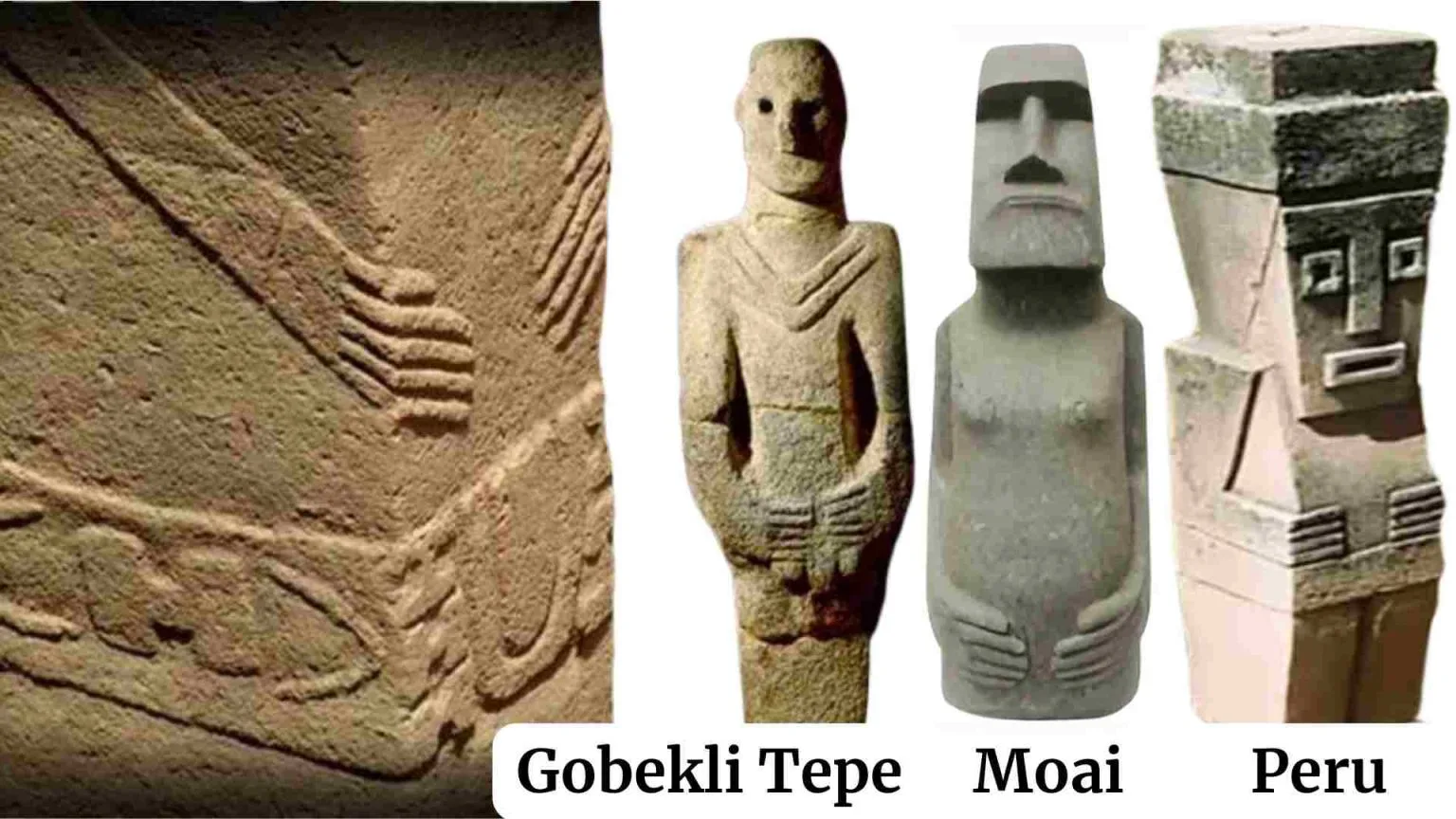
In Neolithic pottery, this pose began to take on a new meaning and most commonly represented the Mother Goddess. Geographically, Dupljaja village lies at the very heart of the Neolithic Vinča culture. Within the Vinča culture (c. 5700–4500 BC), countless figurines — often depicting goddesses or priestesses — share this stance, some even bearing bird-like faces.
Furthermore, this motif is found in traditional Oriental carpet design, in the symbol known as “elibelinde” — literally “hands on hips” — representing womanhood, marriage, and creation.
The skirts depicted on these designes are very remeniscent of the one that Dupljaja figurines are wearing.

The Many Faces of the Bird-Headed Deity
Avian faces here are not artistic quirks — they carry divine and messenger roles.
Identifying the rider of the Dupljaja chariot is no simple task. Bird-faced deities once flourished across a vast cultural corridor — from ancient Egypt and Mesopotamia, through Cyprus and the Balkans, and as far east as the Indus Valley. Yet their attributes shift with time and place. Sometimes they appear as male, sometimes as female, and sometimes as beings whose gender is deliberately ambiguous.
They may embody the sun or the dawn, act as messengers between worlds, or serve as protectors of kings. In some traditions they preside over fertility and renewal; in others, they guide souls to the afterlife.
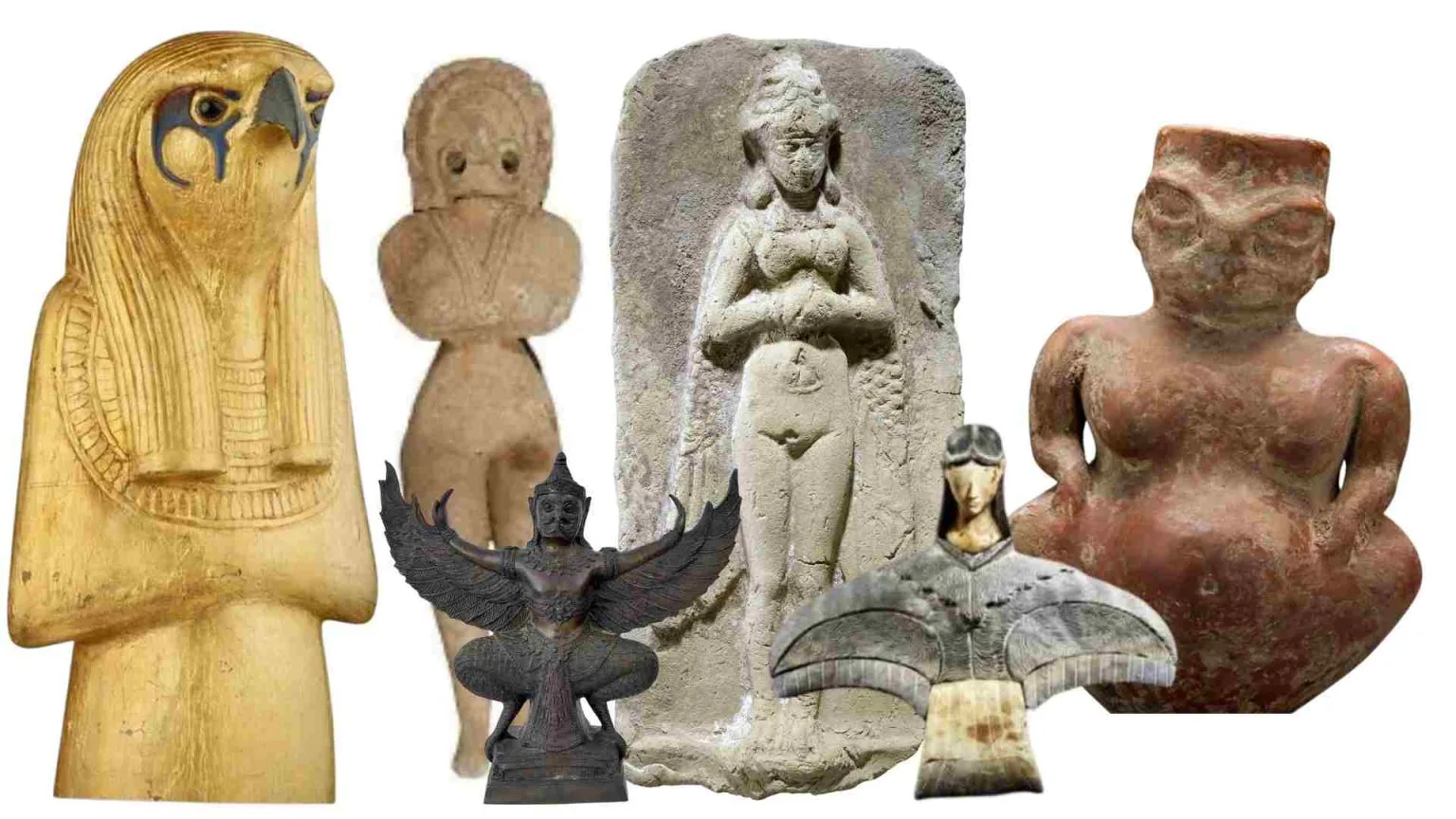
Bird-Headed Males
Take, for example, the Egyptian Horus — a falcon-headed god and one of the most ancient bird-men known to us — here shown in the same commanding pose as the Dupljaja figure.
His roles were many: sky-god, divine protector of the pharaoh, avenger of his father Osiris, and guarantor of order over chaos. Horus was also a god of war and hunting, whose keen falcon eyes saw all from above, yet he could be a patron of kingship and renewal, embodying the daily rebirth of the sun.
However, Horus was never depicted riding in a chariot in Egyptian art. On the other side of the world, though, the equally ancient Garuda was.
The famous stone chariot at the Hampi temple is dedicated to him, echoing the grand processions in which his image would have been paraded. Garuda’s role was that of a divine mount and loyal servant to Vishnu, a cosmic protector who could traverse heaven and earth with the speed of the wind. He was the slayer of serpents, the enemy of demons, and the unyielding guardian of dharma.

In Serbian medieval epic poetry, the grey falcon (sivi soko) is a divine messenger and guide between worlds. The same role was attributed to falcons in numerous steppe cultures of Eurasia.
At the same time, the female counterpart of the grey falcon is the titmouse bird (ptica sjenica), equally popular in Serbian epics. I believe this word is a direct cognate of the Sanskrit śyena (“falcon”), which was also one of the names of Garuda. Sjenica would therefore mean “female falcon.”
Bird-Headed Females
There will always be those who claim that all examples of bird-headed deities arose independently, making any search for a common theme pointless.
However, nothing could be further from the truth. As the following image shows, even male and female deities were sometimes depicted with identical iconography — clear evidence that shared motifs did exist.
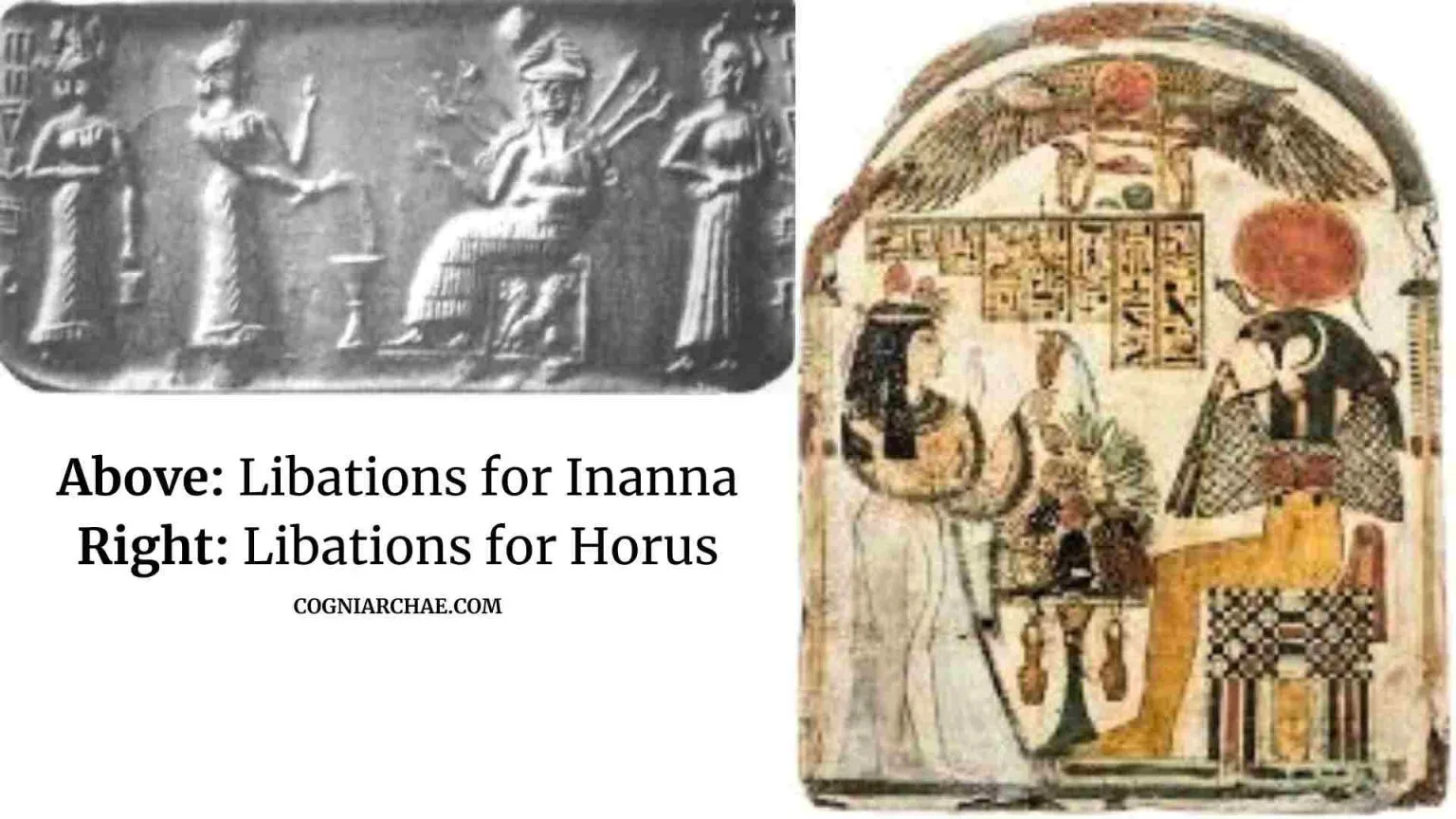
Astarte was a major goddess of the ancient Levant, especially among the Phoenicians, Canaanites, and later adopted by Egyptians. She sometimes combines avian facial features with the hands-on-hips pose and a chariot.
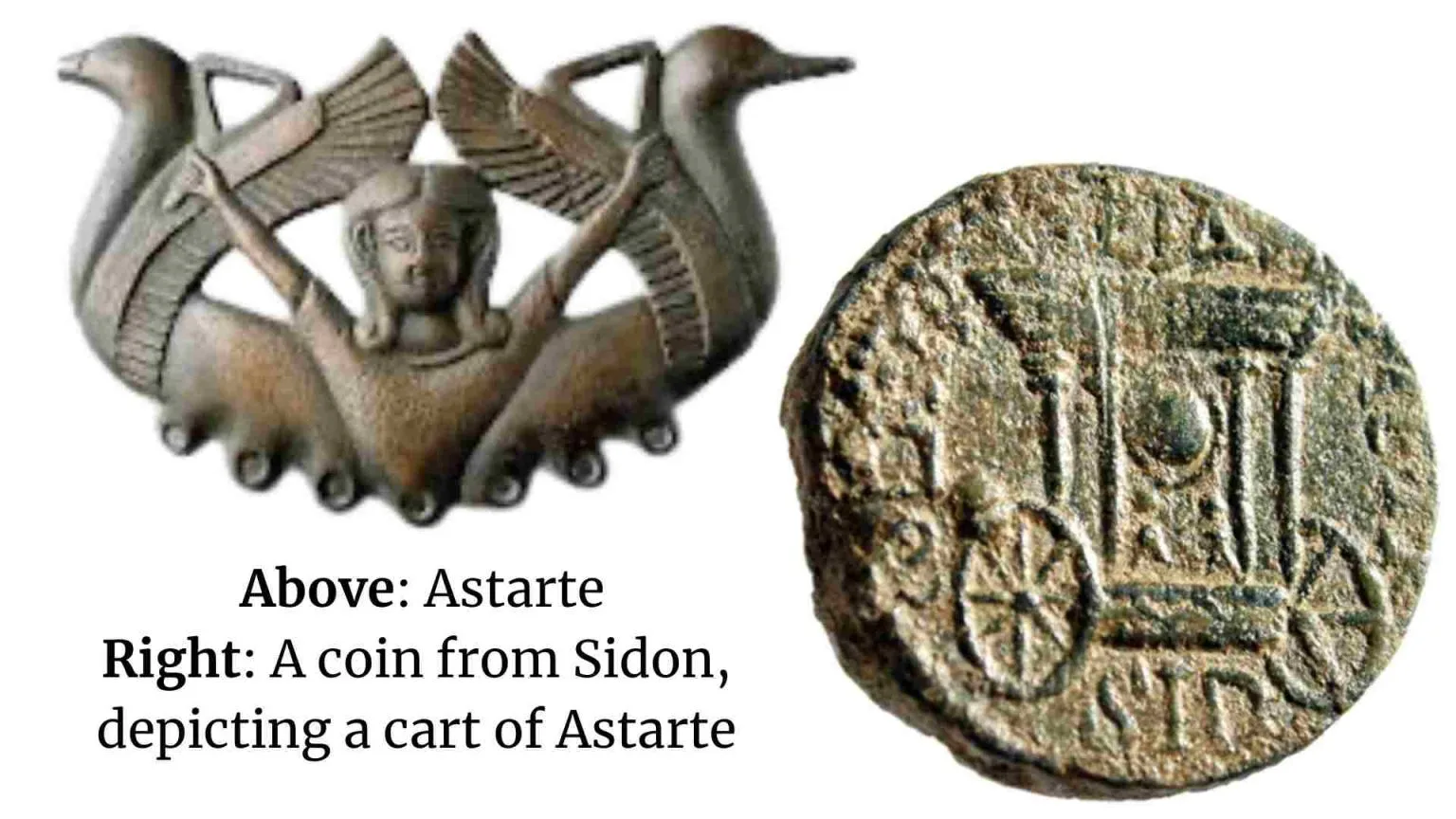
The above depiction of Astarte is very similar to the Solar Boat depictions from the Scandinavian Bronze Age.
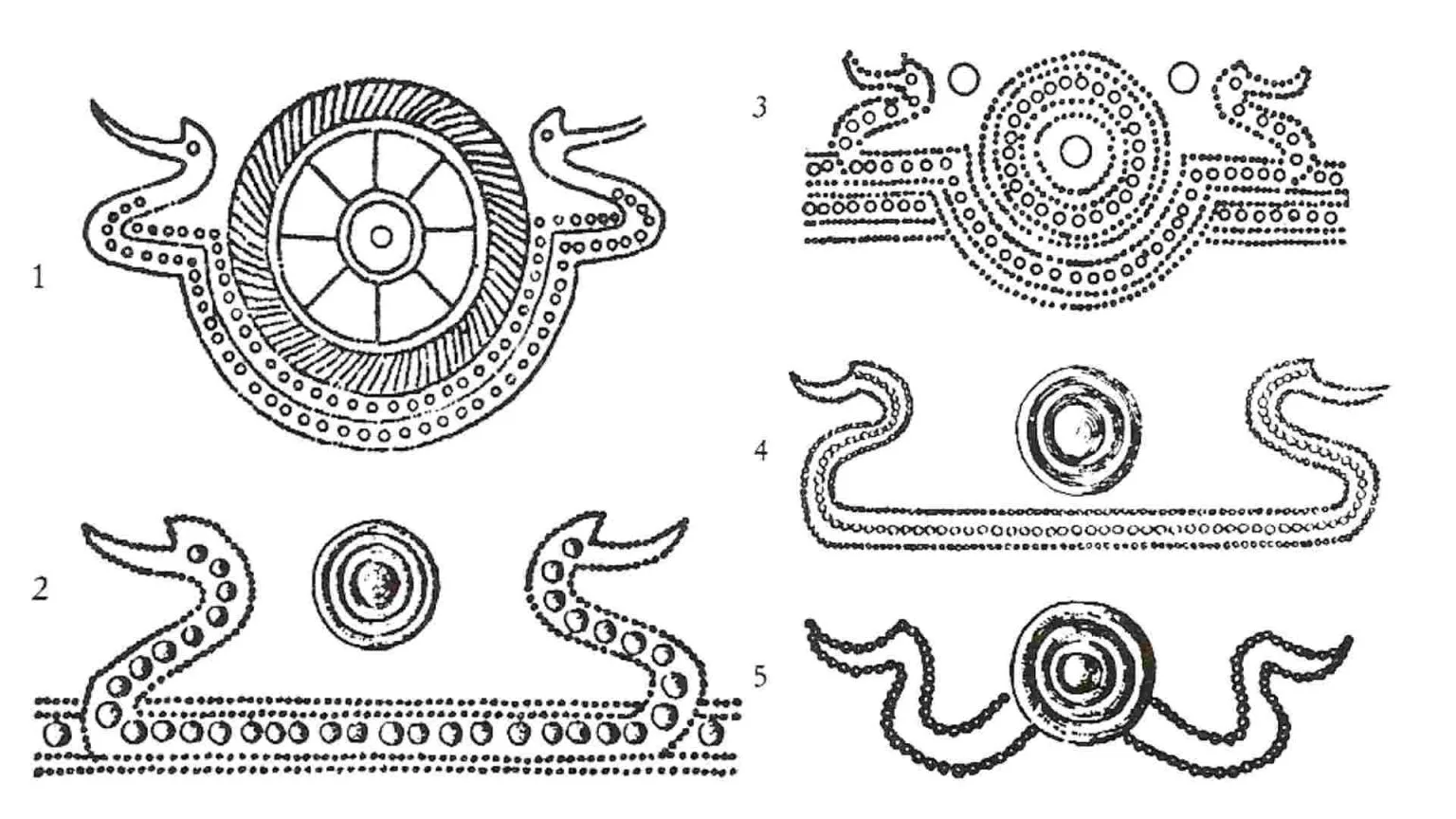
Similarly, in Norse mythology, Freya rides a flying chariot drawn by two great cats. Freya, Inanna, and Astarte are all love-and-war goddesses linked to fertility and the planet Venus, embodying a shared archetype of beauty, power, and cosmic renewal, often depicted with ritual vehicles.
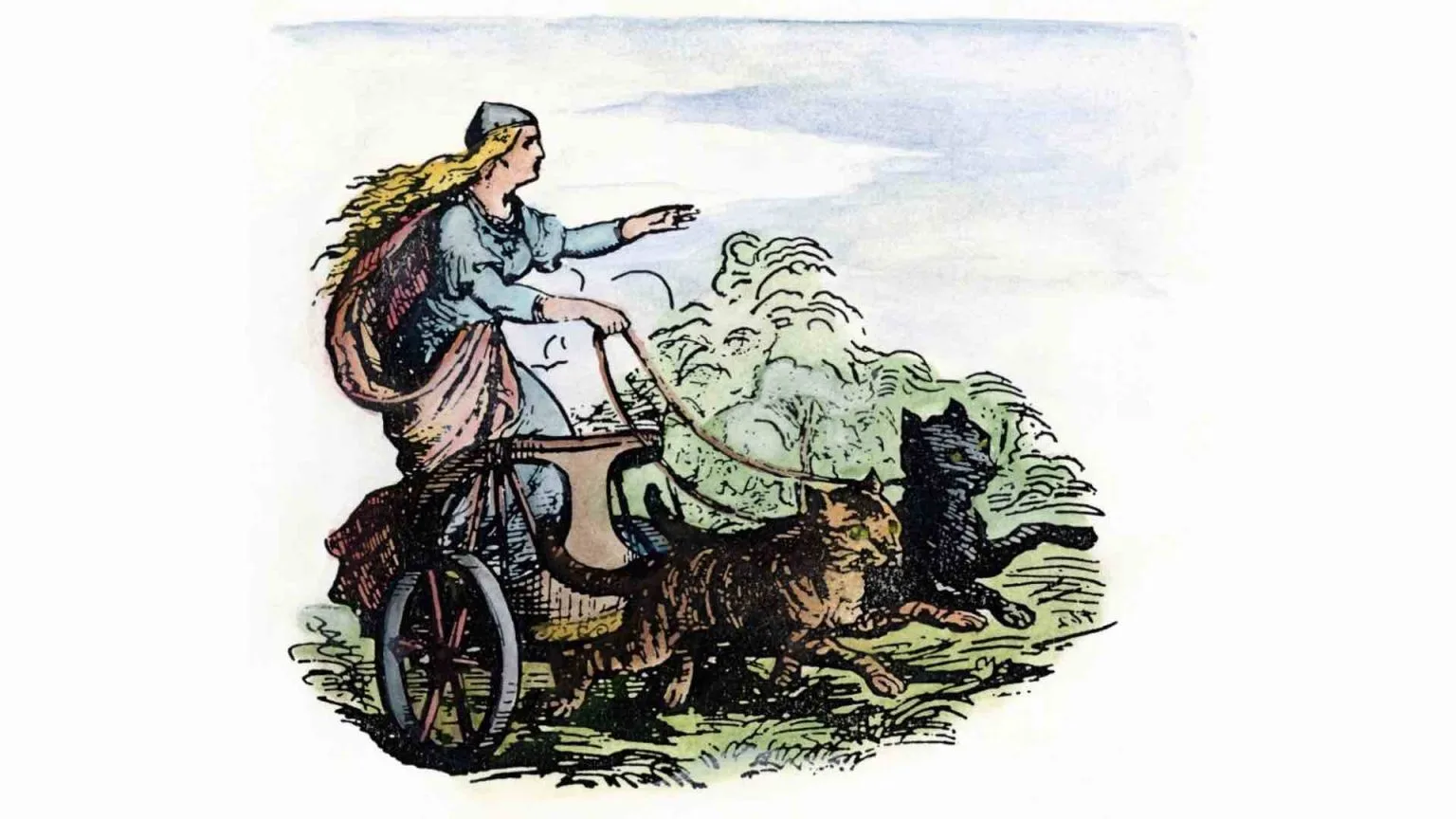
In Slavic tradition, the goddess Vesna embodies youth, renewal, and spring’s triumph over winter’s death-spirit Morana. Particularly among South Slavs and East Slavs, Vesna is celebrated on March 22: villagers fashion clay or dough lark or swallow effigies, which are carried in song through the fields to summon her arrival and fertility.
In Slovenian lore, “vesnas” dwell atop mountains and descend in wooden carts in February, heard only by those attuned to their fate—an image highly resonant with the chariot‑travel motif found in Dupljaja and in Vedic dawn gods.
Hieros Gamos – Spring and Fertility
The Sacred Marriage of Heaven and Earth
Hieros gamos is an ancient ritual or mythic motif of a sacred marriage between a god and a goddess, symbolizing cosmic union, fertility, and the renewal of life.
In Serbia, March 22 holds a special significance. In Serbian Orthodox Christianity, it is celebrated as Mladenci (“the newlyweds”), falling just after the spring equinox. Beneath its Christian veneer, the day preserves a far older tradition — the hieros gamos.
While its official Orthodox meaning commemorates the Forty Martyrs of Sebaste, the older, pre-Christian layer celebrates the union of a newly married couple as a cosmic and agricultural renewal. Timed to the moment when day and night stand in balance and the light begins to grow, it echoes ancient Near Eastern and Indo-European traditions — from Inanna and Dumuzi to Zeus and Hera, or Sūryā and her divine suitors — where such unions ensured fertility and prosperity.
The gifts of honey, bread, and wine offered to the newlyweds recall offerings once meant to bless the land, the household, and the community at the threshold of spring.
The Celestial Twins and the Chariot
The key is in the stars
The Vedic Aśvin-s are not only mythic twins — they are also astronomical figures. The ancients probably identified them with the Gemini constellation, the divine twins. Their chariot, blazing and radiant, maps closely to Auriga, the charioteer constellation just above them in the sky.

Here’s a thought: the shape of the Dupljaja chariot bears an uncanny resemblance to the Auriga constellation. Could this celestial likeness be the very reason the ancients added a mysterious third wheel to the ritual model?
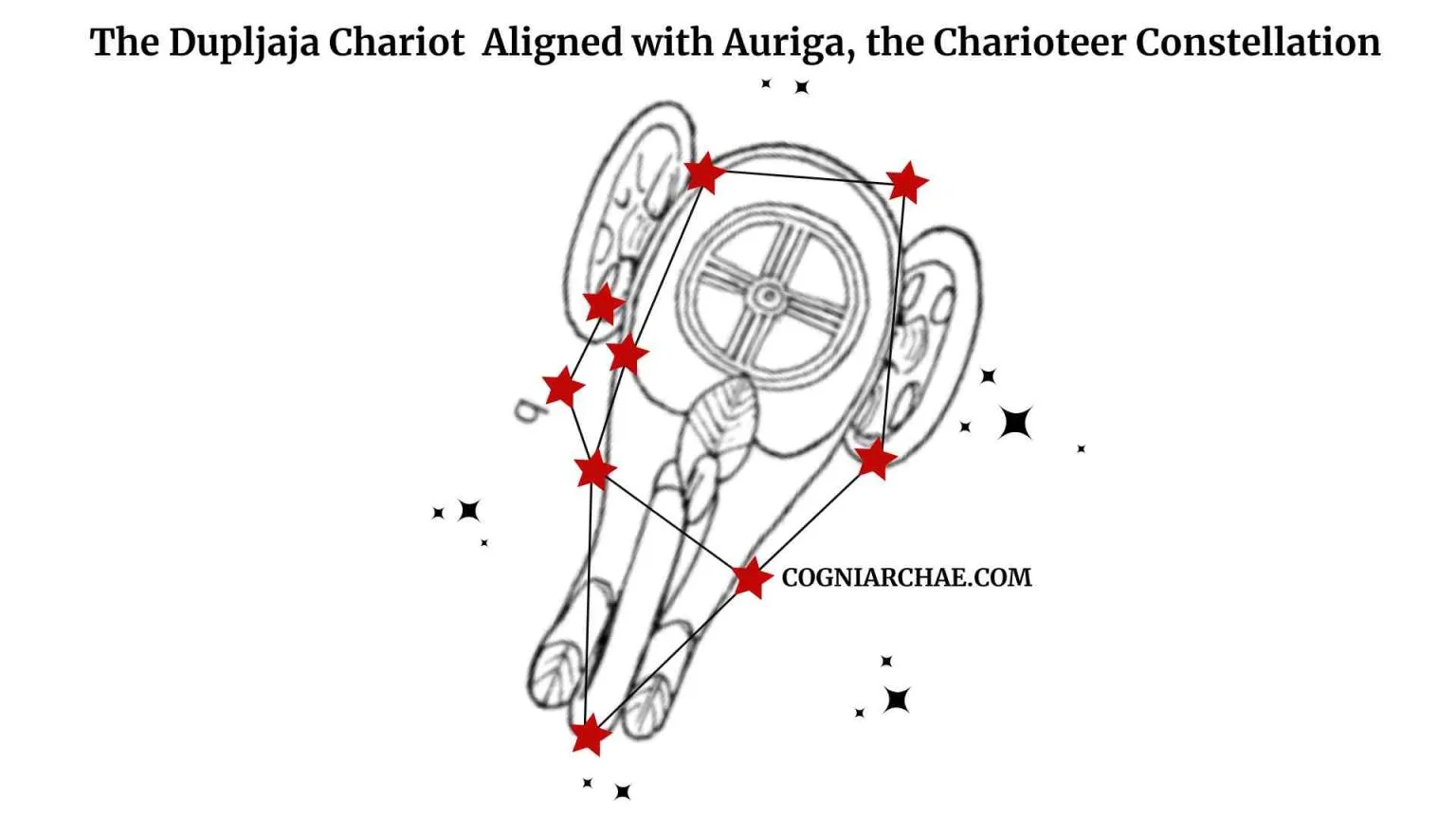
However, all of these mythological layers only align if the spring equinox occurs somewhere between the constellations of Gemini and Taurus.
This celestial pairing — Gemini (the twins) and Auriga (the chariot) — was especially significant during the spring equinox window of the 6th to 4th millennia BC, when these stars heralded the new year and marked the rebirth of the solar cycle in the ancient sky.
Therefore, this imagery wasn’t just symbolic — it was calendrical. The Aśvin-s, as dawn-riders, may have once functioned as timekeepers, their rising announcing the return of the spring, and the turning of the year.
The same symbolism is clearly present on the Dupljaja chariots.
Moreover, looking at the opposite horizon from Gemini, the ancients would see three birds — Cygnus the Swan, Aquila the Eagle, and Lyra the Vulture.
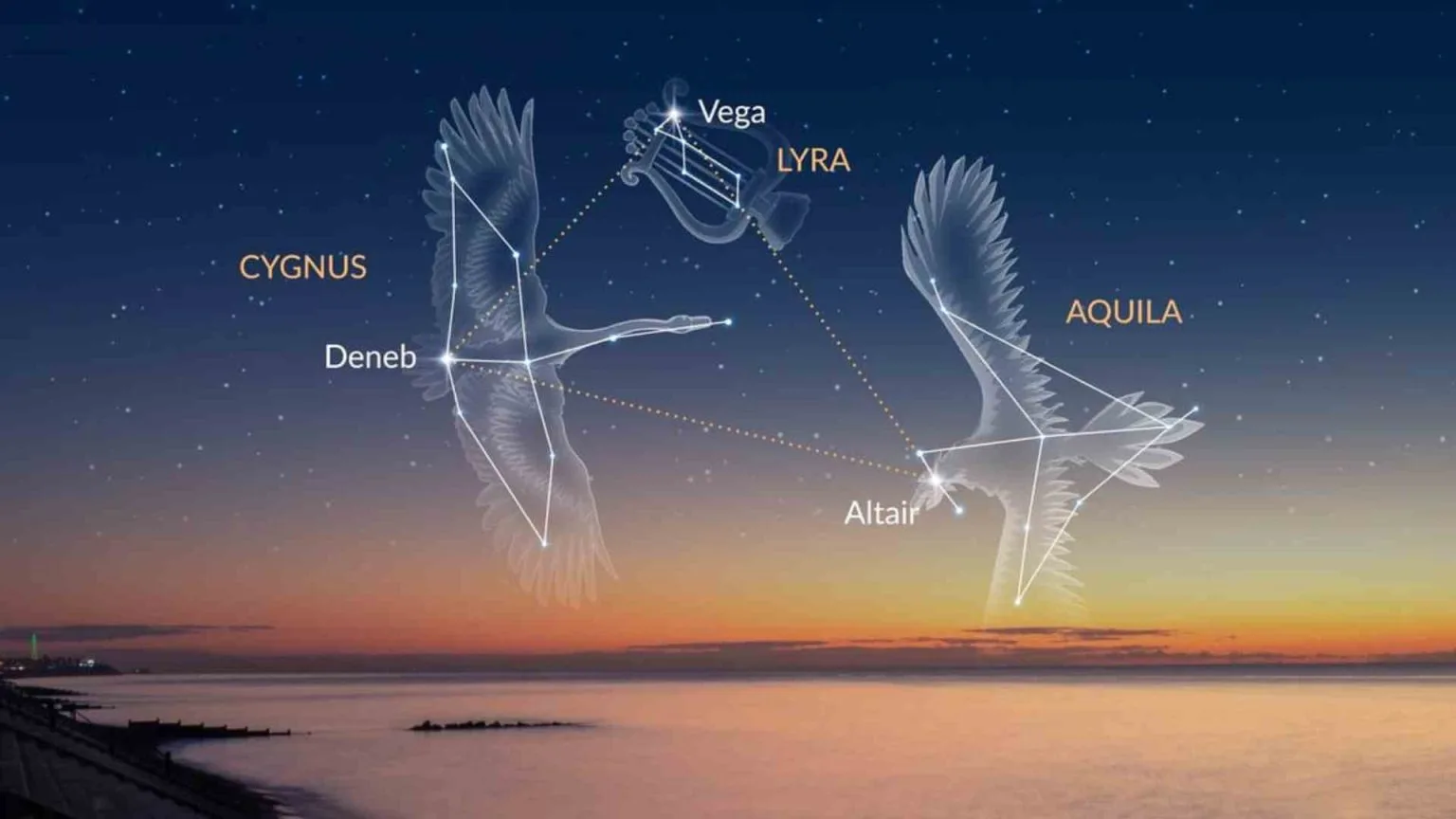
Final Thoughts
Dupljaja chariot is a microcosm of ancient cosmology.
We may never know the myths that created the Dupljaja chariots, but their Mother Goddess stance, avian features, canopy, tricakra design, and echoes of ritual processions are all familiar.
These motifs existed in a continuum stretching from Neolithic Balkan worship to Vedic dawn hymns, Near Eastern sacred marriages, and Slavic seasonal rites.
My five cents is that what we see here is a Bronze Age echo of a much older Neolithic stellar myth and New Year rites, dating to a time when the spring equinox passed between Gemini and Taurus.
In ancient imagery, chariots usually carried moving objects — stars or planets. However, I don’t believe this was a solar symbol. More likely, these chariots carried the planets – originally Mercury, the ruler of the Gemini, and later Venus, who rules the Taurus. Indeed, Mercury, like the falcon, it is the swiftest of all planets, and its androgynous nature could explain the initial duality of the bird-faced deities.
These chariots were found on a cremation ground, but they were burried there after long and deliberate use. Therefore, I don’t believe that their role was to carry the sould to the afterlife, as some have suggested.
They are not relics of death, but a crafted symbol of hope, and the unbroken wheel of life that renews itself.




